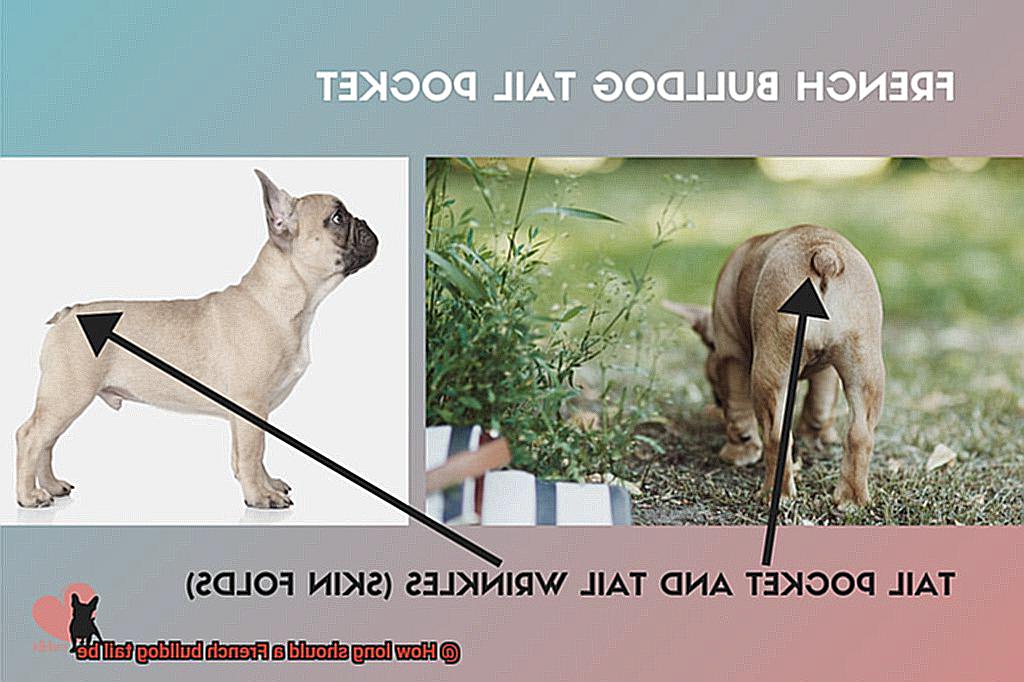How long should a French bulldog tail be?
With their squishy faces and ears that could rival Batman’s, these lovable little furballs have a way of stealing hearts in an instant. But there’s one aspect of their appearance that often leaves us pondering: just how long should a French Bulldog’s tail be?
Join us on this enchanting journey as we delve into the world of French Bulldog tails, uncovering the secrets behind their length, shape, and undeniable charm. We’ll dive into the breed’s captivating history, explore the fascinating realm of genetics, and even discuss the practical implications that come with different tail lengths. By the end, you’ll be armed with all the knowledge you need to appreciate these canine companions on a whole new level.
So, sit back, relax, and grab yourself a cuppa as we embark on this tail-tale adventure through the captivating lives of our beloved French Bulldogs.
What is the Ideal Length for a French Bulldog’s Tail?
Contents
- 1 What is the Ideal Length for a French Bulldog’s Tail?
- 2 What Factors Determine the Length of a French Bulldog’s Tail?
- 3 How Do Breeders Aim for Shorter Tails?
- 4 Does the Length of a French Bulldog’s Tail Affect Their Health or Well-Being?
- 5 Abnormalities and Deformities in French Bulldogs’ Tails
- 6 When to See a Veterinarian for Your French Bulldog’s Tail
- 7 Conclusion
French Bulldogs are adored for their unique appearance, and their short, adorable tails are a defining characteristic. But what is the ideal length for a French Bulldog’s tail? Let’s delve into this topic and explore how to determine the perfect tail length for your furry companion.
Understanding the Breed Standard:
According to the American Kennel Club (AKC) breed standard, the ideal length for a French Bulldog’s tail is “short and set low.” This means that the tail should not extend past the hock joint (equivalent to the human ankle). A shorter tail not only adheres to breed standards but also enhances the overall charm of these delightful dogs.
Genetic Variation:
While breed standards outline the ideal tail length, it’s important to note that some French Bulldogs may naturally have slightly longer or shorter tails due to genetic variations. These variations typically do not impact a dog’s overall health or well-being. Nevertheless, it is crucial to prioritize your dog’s comfort and prevent potential health issues that may arise from excessively long or short tails.
Tail Health and Well-being:
A longer tail may be prone to injury or damage, especially in active dogs who wag their tails vigorously or engage in rough play. Additionally, an unusually long tail can cause balance issues for the dog. Conversely, an extremely short tail could restrict natural movement and expression.
Breeders’ Role:

Responsible breeders play a vital role in maintaining breed standards and producing French Bulldogs with aesthetically pleasing tails free from genetic abnormalities or deformities. These dedicated breeders carefully select breeding pairs to ensure their offspring have properly shaped and proportioned tails.
Tail Abnormalities:
Occasionally, a French Bulldog may be born with a naturally longer tail due to genetic factors or spontaneous mutations. While these dogs may still be healthy and content, their tails may deviate from the traditional breed standard. If you have concerns about your French Bulldog’s tail length or any tail-related issues, it is always best to consult with a veterinarian who specializes in the breed.
What Factors Determine the Length of a French Bulldog’s Tail?
French Bulldogs are beloved for their distinctive appearance, including their adorable little tails. But have you ever wondered what factors determine the length of a French Bulldog’s tail? In this article, we will delve into the genetic makeup, body structure, tail docking, and natural variation that contribute to tail length in these charming canines.
Genetic Makeup:
The secret lies in the genes inherited from a French Bulldog’s parents. Breeders who specialize in French Bulldogs can often predict a puppy’s tail length based on its parents’ tail lengths. The presence or absence of the “screw tail gene” also affects the tail’s length and curvature.
Body Structure:
A French Bulldog’s overall body structure plays a role in tail length. Those with shorter bodies and compact frames tend to have shorter tails, maintaining proportionality with their body size.
Tail Docking:
Tail docking, a surgical procedure practiced in some countries, such as the United States, can impact tail length. If a French Bulldog’s tail is docked at a young age, it will obviously be shorter than if left intact.
Natural Variation:
Just like humans, dogs exhibit natural variation in physical traits, including tail length. Within the French Bulldog breed itself, individual dogs may naturally have shorter or longer tails due to genetic variation.

How Do Breeders Aim for Shorter Tails?
Today, we embark on an exciting journey into the world of tail length and explore the methods breeders employ to achieve shorter tails in our beloved furry friends. Join us as we dive into the fascinating realm of genetics and breeding strategies to unravel the secrets behind those adorable wagging tails.
Understanding the Genetics:
At the heart of tail length lies a complex interplay of genes that control the growth and development of the tail during a French Bulldog’s embryonic stage. To achieve shorter tails, breeders carefully select dogs that carry a specific gene variant responsible for shorter tail length. By breeding these dogs together, they increase the chances of offspring inheriting this desired trait.
Selective Breeding with Purpose:
Breeders go to great lengths to incorporate dogs with naturally shorter tails into their breeding programs. These exceptional canines, identified through meticulous research or observation, possess the coveted genetic variant for shorter tails. By integrating them into their breeding program, breeders significantly enhance the likelihood of producing puppies with shorter tails.
Observing Phenotypic Traits:

Another approach breeders employ is selective breeding based on phenotypic traits related to tail length. Through close observation and evaluation, breeders handpick dogs with naturally shorter tails as breeding stock. By doing so, they amplify the chances of producing offspring with similar traits. This method relies on careful assessment of each dog’s potential to pass on this desirable feature.

Ethical Considerations:
While striving for shorter tails, it is paramount to emphasize that breeders must prioritize the overall health and well-being of their French Bulldogs. Ethical considerations should guide every breeding decision to ensure responsible addressing of any potential health issues or complications associated with shorter tails.
Does the Length of a French Bulldog’s Tail Affect Their Health or Well-Being?
French Bulldogs are adored for their charming appearance, including their tails. But does the length of a French Bulldog’s tail have an impact on their health or well-being? Let’s delve into this intriguing topic and uncover the fascinating details behind tail length and its potential effects on our furry friends.
Physical Considerations:
While the length of a French Bulldog’s tail may not directly affect their health, there are physical factors to consider. A longer tail could increase the risk of injury, as it may become easily caught in doors or furniture. During playtime or physical activities, a longer tail may also be more vulnerable to injuries.
Conversely, a shorter tail could hinder a French Bulldog’s ability to effectively communicate through wagging or subtle movements. It may also impact their balance, which is crucial for brachycephalic breeds like French Bulldogs that already face respiratory challenges.
Happiness and Well-Being:
Within breed standard guidelines, tail length does not significantly impact a French Bulldog’s overall happiness and well-being. However, individual variations and personal preferences should be considered. Some French Bulldogs are born with naturally short or “screw” tails due to genetic variations, which are generally acceptable as long as they do not cause discomfort or health issues.
Consulting Professionals:
To ensure the best care for your French Bulldog, it is always recommended to consult with a veterinarian or reputable breeder. They can provide guidance on breed standards and help you make informed decisions regarding your dog’s tail length.
Abnormalities and Deformities in French Bulldogs’ Tails
French Bulldogs are known for their adorable appearance, and their tails are no exception. However, it’s important to note that abnormalities and deformities can affect these cute little tails. Let’s explore the intriguing world of French Bulldog tail troubles.
One common abnormality is the “screw tail,” where the tail twists or curls in a funky way. Imagine a tail doing the twist dance move all day long. While this may look quirky, it can actually cause discomfort and difficulty for your furry friend.
Another issue is the “stumpy” tail. French Bulldogs already have naturally short tails, but some may have even shorter tails than usual. It’s like having a mini version of a mini tail. This can be due to genetics or developmental problems, so it’s important to keep an eye on it to prevent infections or injuries.
But wait, there’s more. Some Frenchies are born without a tail at all. Yes, you heard that right – no tail. This is known as “taillessness” or “short-tail syndrome.” It may seem strange, but don’t worry, it usually doesn’t pose any major health risks for your pup.

Other abnormalities include kinks, corkscrews, or bent tails. It’s like having a tail with its own unique personality. These can be caused by genetics or birth trauma. While they may not always cause discomfort or hinder your Frenchie’s mobility, it’s still important to keep an eye out for any signs of pain or infection.
If you notice any tail abnormalities in your French Bulldog, don’t panic. Just consult with your trusted veterinarian. They’ll be able to assess the situation and provide necessary guidance and treatment. In severe cases, surgery may be required to correct the deformity or relieve any discomfort.
To prevent these issues in future generations of French Bulldogs, responsible breeding practices are crucial. Choose breeding pairs without any history of tail deformities and create a stress-free environment during pregnancy and birth.
When to See a Veterinarian for Your French Bulldog’s Tail
We all love those adorable little tails, wagging with excitement whenever our furry friends see us. But did you know that sometimes these cute tails can run into trouble? In this blog post, let’s explore when it’s necessary to seek veterinary care for your French Bulldog’s tail. So, let’s dive in and ensure the health and happiness of our beloved companions.
Screw Tail Syndrome:
One common issue that may require a trip to the vet is “screw tail” syndrome. This condition occurs when the tail becomes twisted or curled, resembling a corkscrew. Not only can it lead to discomfort and skin infections, but it may also cause difficulties with bowel movements. If you notice any abnormal twisting or curling of your Frenchie’s tail, it’s time to consult a veterinarian.
Tail Injuries:
French Bulldogs have delicate tails that can easily be injured through accidents or rough play. If your dog’s tail appears swollen, bruised, or if they exhibit signs of pain when you touch it, don’t hesitate to seek veterinary care. Remember, it’s better to be safe than sorry when it comes to your pup’s well-being.
Hemivertebrae:
Another condition that requires a vet’s attention is “hemivertebrae.” This occurs when the vertebrae in the tail are abnormally shaped or fused together. It can cause pain, mobility issues, and even paralysis in severe cases. If you suspect your Frenchie may have hemivertebrae, consult a veterinarian for proper diagnosis and treatment options.
Persistent Drooping or Difficulty Wagging:
If your French Bulldog’s tail is constantly drooping or they’re having difficulty wagging it, it could be a sign of an underlying health issue. Tail drooping may indicate pain, muscle weakness, or nerve damage. A veterinarian will be able to assess the situation and recommend appropriate treatment to alleviate any discomfort your pup may be experiencing.
Conclusion
In conclusion, the length of a French Bulldog’s tail is a vital factor in both their appearance and overall health. According to breed standards, the ideal tail should be short and set low, not extending beyond the hock joint. However, it’s important to acknowledge that some French Bulldogs may naturally have slightly longer or shorter tails due to genetic variations.
While tail length may not directly impact a dog’s well-being, there are crucial considerations to bear in mind. A longer tail can be more susceptible to injury and may cause balance issues, especially for active pups. Conversely, an excessively short tail could limit natural movement and expression.
Responsible breeders play a pivotal role in upholding breed standards and producing French Bulldogs with perfectly shaped and proportioned tails. They meticulously select breeding pairs to ensure offspring with aesthetically pleasing tails that are free from genetic abnormalities or deformities.
If you have any concerns regarding your French Bulldog’s tail length or any related issues, it is always advisable to consult with a veterinarian who specializes in the breed. They can offer guidance on breed standards and assist you in making well-informed decisions regarding your dog’s tail length.
Ultimately, comprehending the ideal tail length for French Bulldogs and considering their individual needs will contribute significantly to their happiness, comfort, and overall well-being.




